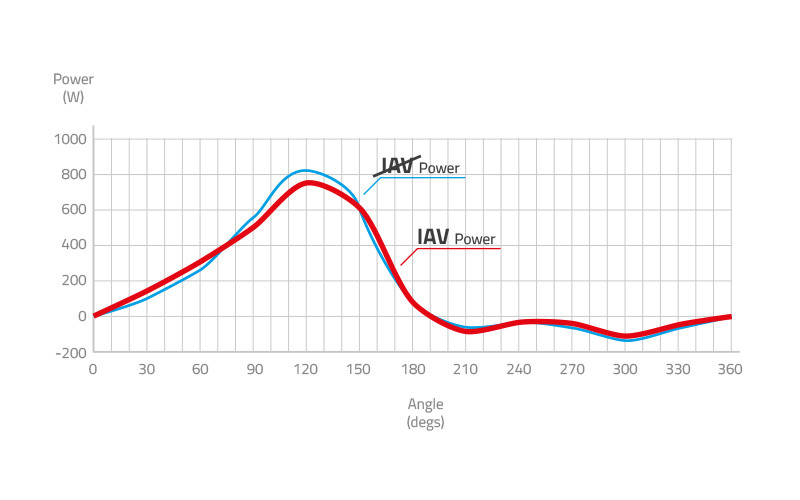The advantages of the IAV Power
Top Articles
At the very basis of the accuracy and consistency of the data transmitted by the Assioma power meters we can find the IAV Power System, which detects all our pedalling variations and factors it into the power calculation.
In fact, our pedalling is never regular or homogeneous. Think for example about sprints, climbs, or the use of oval chain rings.
And it’s right here that lies the difference with most power meters on the market which, by calculating power on the basis of the average angular speed per pedalling revolution, erroneously consider this latter as always regular and uniform.
Basics: how does a power meter work?
Power meters are placed on the rotating parts of the bike (pedals, crank arms, hub, spider, etc.) and, regardless of their technical and construction differences, they all calculate power based on two quantities: force and angular velocity.
Both the force and the angular velocity are not constant, but vary continuously within the same revolution.

The variations, which can also be very significant, depend on several factors, such as the pedalling style and athletic preparation, the type of chain rings used, the slope of the ground, the model of roller used, etc.
This being considered, to guarantee the maximum degree of accuracy in any situation, power calculation should take into account the variations of both force AND angular velocity. Power meters use to detect the variation of force through dedicated sensors (i.e strain gauges) hundreds of times per second during the entire rotation. The values measured are called samples.
On the other hand, the variation of angular velocity seems to be commonly neglected and not sampled. In fact, many power meters use the average angular velocity instead of the real instantaneous value. This inevitably introduces an unpredictable error into the power calculation.
Where do some power meters go wrong?
Using the average value (Average) instead of its instantaneous form (Real), means considering each pedal stroke as perfectly smooth and uniform: this type of pedal stroke does not.
A research by Favero Electronics (access to research material) clearly shows that not taking into account the typical changes in the angular velocity has a negative impact on the accuracy of power meters in any pedaling situation, especially when using oval chain rings. In the paper analyzing the "Influence of Angular Velocity of Pedaling on the Accuracy of the Measurement of Cyclist Power" you can easily see how a power measurement system that does not detect instantaneous angular velocity introduces an error that can reach 4.5%.
What are the advantages of the IAV Power System?
The IAV Power system (Instantaneous Angular Velocity-based Power calculation) calculates power based on the real instantaneous angular velocity.

Thanks to proprietary software solutions Assioma fully exploits a built-in three-axis gyroscope to detect the real trend of the angular velocity with all its variations, and factors it into power calculation. Not only this increases the overall accuracy to ±1% but it also guarantees the same precision in real pedaling conditions. Not just in laboratory tests.
Here are some of the most common situations in which the IAV Power system proves its relevance:
-
Piston-like pedaling: especially in terrains with steep slopes, standing or sitting, cyclists tend to give very irregular pedal strokes with very pronounced variations in angular velocity.
-
On a bike trainer: each training roller has a braking system to recreate the right experience for cyclists. This system changes from model to model, and since the inertia produced impacts directly on the angular velocity of the pedal stroke, there is an immediate influence on the expression of power.
With non-circular chain rings: oval or elliptical chain rings are designed to take advantage of the pseudo-sinusoidal course of the pedaling torque. In these cases, it is essential to have a power meter capable of instantaneously detecting angular velocity, because variations in this velocity are not only inevitable, but even mechanically accentuated.

The perfect combo? IAV Power System and ATC
ATC, which stands for Automatic Temperature Compensation, is a system that recognizes and compensates for any temperature variation between -10° and +60°.
This, in support of the IAV Power System, helps to ensure a correct reading of the power data regardless of the environmental conditions, for a measurement that is always precise and homogeneous despite any thermal variations.
To learn more about all peculiarities and strengths of Assioma have a look at “Assioma Uniqueness”
Read the other articles
- Assioma PRO RS: precision on the road, power at your feet
- The core of Assioma PRO
- Advantages of Rechargeable Batteries in Pedal-Based Power Meters
- Rock solid reliability
- How to install the Assioma PRO pedals
- Rechargeable battery vs. Replaceable battery?
- Assioma’s uniqueness
- The resistance of Assioma: tested in laboratory, proven on the road
- How to Update the Firmware of Assioma
- Data measured by the Assioma power meter pedal
- The Accuracy of Assioma: consistent and guaranteed
- Install Assioma just like a common pedal
- Assioma Recharging System: Smart and Green
- Assioma DUO-Shi: All you Need to Know
